| |
 |
 |
 |
 |
JOCK
DEMPSEY
|
 |
Tonight's demo is our 100th! Appropriately it is one of the first demos I saw Bill do.
The photos are from that 1998 demo at the annual Alabama Forge Council meet at Tannehill Park near Birmingham, Alabama.
Without Bill's tireless dedication to doing iForge demos week after week there would have been no iForge.
This is Bill's 44th demo, nearly half the total!
Thank you Bill!
|
 |
P-F
|
 |
We all owe Bill! Thanks Mr Epps!
|
 |
Ntech
|
 |
Yes, thank you Mr. Epps and Sharon for all your efforts.
|
PAW PAW
|
 |
Bill, Just want to thank you and Sharon for all of the iForge demo's. You're a credit to your profession, and you've got a real help mate beside you.
|
 |
 |
BILL EPPS
|
 |
Who's that good looking fellar at the top of the page? (Just kidding)
This is a one-piece "Hummingbird" that was shown to me by a friend of mine from Pinedale, WY who was here visiting our shop a few years back when NTBA had him as a guest demonstrator at our conference. I demonstrated this technique at the Tannerhill Alabama Forge Council Conference in 1998.
|
 |
 |
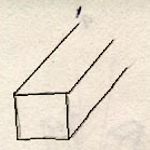
Figure 4 |
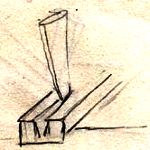
Figure 5 |
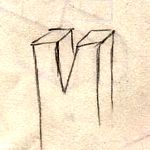
Figure 6 |
 |
BILL EPPS
|
 |
You start w/a square bar (I use 5/8"), but any size will work, 1/2" 3/4, 5/8" or whatever size you want to make the bird. We start by making a split 1/2 through the bar on one side and 1/2 way through on the other side, approx. 1" long.
|
 |
 |

Figure 7 |

Figure 8 |
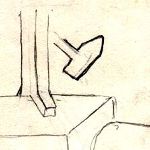
Figure 9 |
 |
BILL EPPS
|
 |
I use a hot cutter to bottom out the split, then I go to a rounded, blunt punch to put a radius in the bottom of the split. (This step helps keep a cold shunt out of the project). Then I smooth it up on the edge of the anvil and w/a hot rasp. Don't taper, just smooth it up.
|
 |
 |

Figure 10 |

Figure 11 |
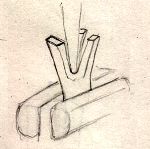
Figure 12 |
 |
BILL EPPS
|
 |
Then we close the split back up, rotate it 90 deg. and split one/half of it again as in Fig. 11. Run this split a little bit past the first cut. Then again, I take a blunt punch in the vice to round the bottom of this cut to help prevent cold shunt. Also, I run the blunt "radius" punch to the end of the second cut.
|
 |
 |
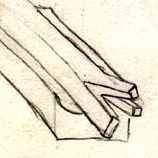
Figure 13 |
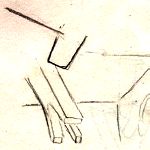
Figure 14 |

Figure 15 |
 |
BILL EPPS
|
 |
Now I use a bottom 1/2 round fuller tool in the anvil to round the bottom edge of what will become the body slightly. Then I go to the edge of the anvil and set it down w/a one-half blow just in front of what will become the wings. Now I open the tail section up a little bit.
|
 |
 |
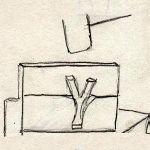
Figure 16 |
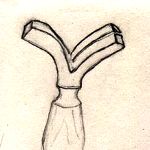
Figure 17 |
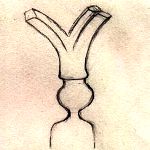
Figure 18 |
 |
BILL EPPS
|
 |
Fig. 16: Now, at the set down point, I go to my guillotine tool and round up what will become the back of the head, Fig. 17. In Fig. 18, I come to the front of the head, and I start making the rounded shape of the head. (Don't make it too thin at this point, or you will lose your handle.)
|
 |
 |

Figure 19 |
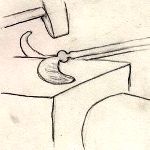
Figure 20 |

Figure 21 |
 |
BILL EPPS
|
 |
At this point, I open the wings up where they can be shaped. And I do this by spreading them with a cross-pien hammer, and spreading the widge of the wings as well as the length leaving cross-pien hammer marks in it to give the impression of feathers. Coming over the horn of the anvil, I spread the end of the tail with the cross-pien hammer to give the look of tail feathers. Also, I give it a downward curve to the tail.
|
 |
 |
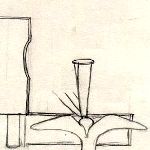
Figure 22 |
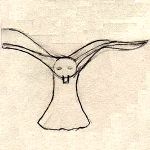
Figure 23 |
 |
 |
BILL EPPS
|
 |
I go back to my guillotine tool (only because it is easier) and use a hot cutter to cut off the beak from from the handle. I cut it about the width of the guillotine tool which is about 1/4" to leave me some metal to draw out the long pointed beak. (That is what distinguishes it as a hummingbird.
|
 |
 |
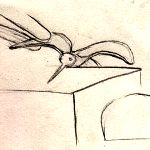
Figure 24 |
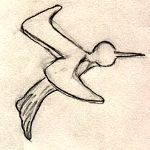
Figure 25 |
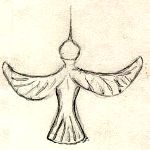
Figure 26 |
 |
BILL EPPS
|
 |
Now holding it w/a pair of tongs, take a good heat on the beak, and draw it out to a needle point. Use a small eye punch to punch him some eyes. He should look like this.
|
 |
 |

Figure 1 |
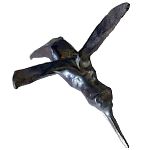
Figure 2 |
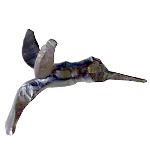
Figure 3 |
 |
BILL EPPS
|
 |
I make two other versions of a humming bird, but I weld the wings on them. This one makes a good demonstration for the public where you wouldn't want to be using a welding machine or risking forge welding if you are trying to make a good impression.
|
 |
jj2k
|
 |
Bill,that was great. I really do appreciate all your work.:) What finish do you use?
|
 |
BILL EPPS
|
 |
This is not an exact copy of a hummingbird, but to the minds eye, it is preceived as such, and makes for a real good demo. Women seem to love these little hummingbirds. Any questions.
|
 |
P-F
|
 |
another classy demo Bill!
|
 |
BILL EPPS
|
 |
I usually hot wire brush it, jj2k and either spray it w/clear acrylic or rub bees wax on it when it is still warm.
|
 |
Paw Paw
|
 |
Another good un, Bill!
|
 |
BILL EPPS
|
 |
If you are gonna use bees wax, make sure the piece is not too hot.
|
 |
jj2k
|
 |
What do they sell for?
|
 |
Robert-Fitch
|
 |
thanks for the demo and all your hard work Bill
|
 |
BILL EPPS
|
 |
Thanks guys for your attendance. Guess I will go back to the pub now.
|
 |
Ntech
|
 |
Great demo Bill, Thanks.
|
 |
P-F
|
 |
You know a man is a good blacksmith when he can take a cold bar of steel and make it into something women like!
|
 |
BILL EPPS
|
 |
I sell the small ones for $30-40 (Whatever you feel the piece is worth, and what your market will bear):) It takes me about 25 minutes to make one, but I have made a lot of them and use them as ornamentation on wine cellar doors, pot racks or wherever a customer would like one places, usually in conjunction w/flowers and leaves.
|
 |
BILL EPPS
|
 |
I do sell them often just hot off the forge too:)
|
 |
BILL EPPS
|
 |
See ya'll back in the Pub if there are no more comments or questions?
|
 |
JOCK D.
|
 |
Great demo Bill! Looks just like the humming birds that fly past my window!
|
 |
JOCK D.
|
 |
NOTE: Other details of this demo have been done previously. The flower, eye punches and the making the guillotine swaging tool.
|
 |

